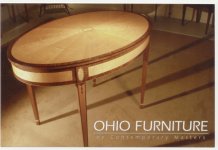I am considering building an elliptical shaped table. I just finished a pair of Lolling chairs and need a table to go in between them. I've seen several methods of building something like this, but I thought I would ask if anybody has any good tips. I've seen lamination, brick, etc. techniques for building the skirts. To complicate things, I want to add a drawer on each long side of the skirts. I'm calling this a his and her table. I'm working on a drawing. I want to do some nice veneer on the top (radial pattern with cross banding) and use a tapered leg. Thanks for the help.
Tony
Tony

